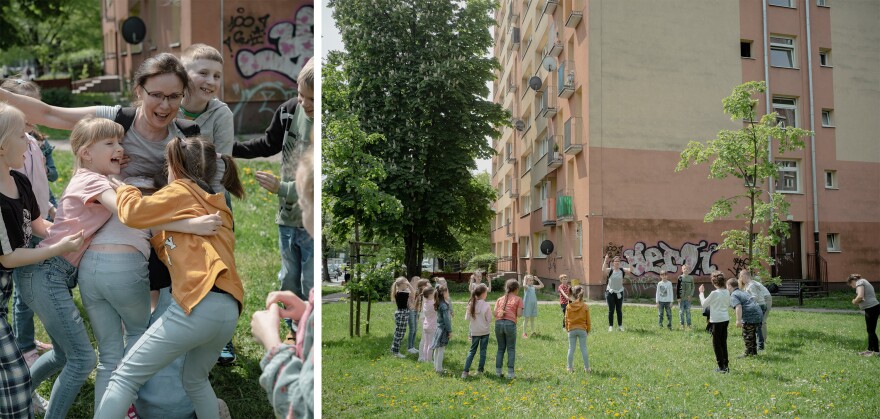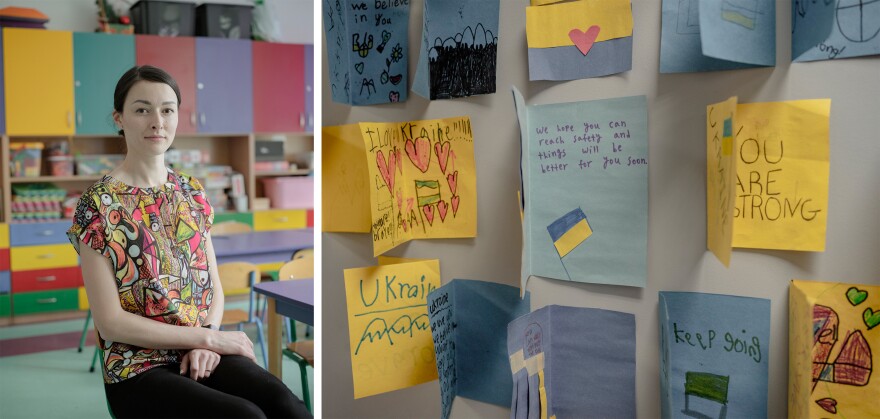It's midday at Poland's Warsaw Ukrainian School and the teachers are doing their best to shepherd students to their next lesson. The adults are outnumbered, and no match for loud, energetic 7- and 8-year-olds who have flooded the hallways during the afternoon passing period.
The Ukrainian school looks like any grade school: student artwork lines the walls, the youngest students sing nursery rhymes to memorize "heads, shoulders, knees, and toes," and the teacher's lounge is a solace for diligent instructors. But there is nothing typical about this school.
"We decided that we will take children from the hottest points of Ukraine, like Mariupol, like Bucha, like Izum," says director, Oksana Koleshyk. "Students who have no possibilities to learn in Ukraine."
When the war broke out and people began rushing into Poland, a group of Ukrainian educators used money from nonprofit organizations to open the school in just 24 days.

It sits in an unused college building in the city's southwest. It was founded by Ukrainian refugees who have developed the schedule and coursework. It is where the pressure of living in a new country with a new language is eased by a Ukrainian-speaking staff and student body.
About 300 teachers applied for 22 positions. And 400 kids applied for 270 slots. All of them — teachers, staff, and kids — are refugees.
The staff is committed to taking in students from the war's biggest hotspots. But that means taking in the most traumatized children. Teachers say the first few weeks of class were difficult.
"I saw just empty eyes," says deputy director, Oksana Vakhil. "They were just sitting looking in. When you see the first graders whose nature is to move, to shake, and not to freeze, and you see that they are frozen, they have no emotions, you try to do this material and that material and you see no reaction. It's really scary."

The school has two psychologists on staff and the teachers received training on identifying and addressing trauma.
Vakhil is an art therapist and teacher of 20 years who uses her background to help her students cope. In some cases, that means throwing out the lesson plan.
"We speak more with them, we draw more with them, we make music and we do not disturb them," Vakhil says.
More than 6 million people have fled Ukraine since Russia invaded in late February. Neighboring Poland has taken in most of them and the country has provided resources to help them transition into their new life. That has meant creating new schools or expanding the student body in established schools.

At Primary School No. 148, a public school in another part of Warsaw, this has meant pivoting to accommodate an influx of 100 Ukrainian students.
The desks have been painted blue and yellow for Ukraine, and the Polish students have special permission to use Google translate to communicate with their new Ukrainian classmates. But more students mean more work for teachers, who already don't have access to resources.
"It's a really big challenge, and they were not prepared for this," says English teacher Eva Dudzinska.
She hasn't been directly impacted by the addition of 100 new students to her school, but she says some of her colleagues who teach in Polish are struggling.

David Miliband, CEO of the International Rescue Committee has seen firsthand how resources can be strained if additional assistance is not allocated across the board.
Helping refugee students and integrating them into the school system takes "additional help for teachers, additional support for the kids, additional support for the other kids who suddenly find, like others, 10 more people in my class," Miliband says.
He says Europe's response to the Ukrainian refugee crisis should help reframe the narrative around refugees.
"I think this response needs to set the benchmark for the way the world needs to respond globally," he said. "Anyone who tells you an exodus of people is unmanageable, is wrong ... I think that our experience now is that there is good practice for how to do this dispersed integration effectively."


Dudzinska, the English teacher, agrees.
"It was like when the pandemic started, we needed to go through that new era of online education and we did it well," she says. "It took some time for us to learn how it functions and now it's the same."
Poland's minister of education Przemysław Czarnek said the country had absorbed more than 75,000 Ukrainian students into Polish schools. The country is bracing for 700,000.
All across Poland, kids, parents, and teachers are trying to adapt — struggling to stay flexible.
Fourteen-year-old Masha Zamoros came to Poland with her parents and has been at the primary school for a few months. Her 28-year-old brother stayed in Ukraine as men of fighting age were not allowed to leave.
Masha says her brother runs to the shelter when he hears sirens. She doesn't know when she will see him again. Amid English and Polish language classes, math and science, the developments in Ukraine dominate Masha's thoughts.
"It's hard because if everything would be normal, it would be just different. But now I have to think about my home, if it is still standing or bombed," she says.

It is a frustration shared by Inna Demchenko, the mother of a 9-year-old student at the Polish school whose father is still in Kyiv.
"I'm trying to create some stories because he doesn't need truth," she says of her son. "I always say tomorrow, in a few weeks, in a month, everything will be OK and then you'll see your dad. And for some time of course, it helps. The longer he stays, the less he thinks about the situation."
Demchenko says she's surprised that Polish people are still as welcoming today as they were when the war began more than two months ago.
For some of the students, school introduces structure, a sense of normalcy, and a place where they can make new friends. For 15-year-old student Diana Norchak, the Ukrainian School restores a sense of home.

"We have just a little piece in Warsaw, a little piece of Ukraine," she says. "Because here's people from my native city, from my native country, that speak my native language."
After escaping war and living through the largest refugee crisis in Europe since World War II, Norchak is finally starting to feel like a normal teenager. And now, all she really wants is a prom.
Copyright 2023 NPR. To see more, visit https://www.npr.org.










